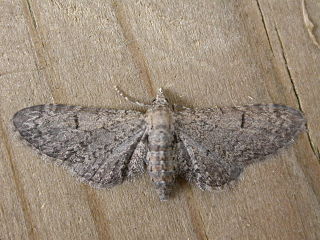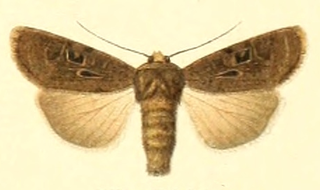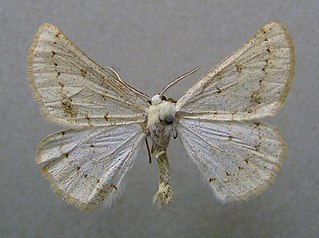
The Noctuidae, commonly known as owlet moths, cutworms or armyworms, are the most controversial family in the superfamily Noctuoidea because many of the clades are constantly changing, along with the other families of the Noctuoidea. It was considered the largest family in Lepidoptera for a long time, but after regrouping Lymantriinae, Catocalinae and Calpinae within the family Erebidae, the latter holds this title now. Currently, Noctuidae is the second largest family in Noctuoidea, with about 1,089 genera and 11,772 species. However, this classification is still contingent, as more changes continue to appear between Noctuidae and Erebidae.

Chelis is a genus of tiger moths in the family Erebidae. There are more than 30 described species in Chelis, found in the holarctic.

Leptarctia is a monotypic tiger moth genus in the family Erebidae described by Stretch in 1872. Its only species, Leptarctia californiae, was described by Francis Walker in 1855. It is found in western North America, from New Mexico and Colorado to California and north to British Columbia. The habitat consists of open forests, meadows and clearings in the mountains.

Eupithecia ultimaria, the Channel Islands pug, is a moth of the family Geometridae. The species was first described by Jean Baptiste Boisduval in 1840. It can be found in Europe, where it is found in Portugal and Spain, coastal western and southern France, Italy, the Mediterranean islands including Cyprus and Greece. It is also found in southern England and the Channel Islands. Furthermore, it is present in North Africa, Lebanon, Israel, Iraq and Iran.

Amata huebneri, the wasp moth, is a moth in the genus Amata of the family Erebidae. The species was first described by Jean Baptiste Boisduval in 1829. It is found from the Indo Australian tropics to northern Australia.

Heliothea is a genus of moths in the family Geometridae erected by Jean Baptiste Boisduval in 1840.
Mesogona rubra is a moth of the family Noctuidae. It is found in the Cascade Mountains north to Skamania County, Washington, in the Klamath Mountains, on the Pacific coast from central Oregon to central California, and in the Sierra Nevada.

Chersotis andereggii is a moth of the family Noctuidae.

Leptophobia aripa, the common green-eyed white or mountain white, is a butterfly in the family Pieridae. It is native to Mexico, Central America and South America, but strays may be found as far north as southern Texas.
Eupithecia undata is a moth in the family Geometridae first described by Christian Friedrich Freyer in 1840. The North American Moth Photographers Group lists it as a synonym of Eupithecia lafontaineata. It is found in the Pyrenees, Alps, the Massif Central, the Tatra mountains, on the Balkan Peninsula and in Romania. It is also found in North America, where it has been recorded from Wyoming, Montana, Idaho, Colorado, Nevada and Oregon.

Dyscia conspersaria is a moth of the family Geometridae first described by Michael Denis and Ignaz Schiffermüller in 1755. It is found in south-eastern Central Europe and Asia Minor.

Caradrina selini is a moth of the family Noctuidae. It was described by Jean Baptiste Boisduval in 1840. It is found in most of Europe, North Africa and the Near East.
Chelis dubatolovi is a moth of the family Erebidae. It was described by Saldaitis and Ivinskis in 2005. It is found in the south-western Altai and south-western Tuva in Russia. The habitat probably consists of mountain tundra.

Chelis puengeleri is a moth of the family Erebidae. It was described by Otto Bang-Haas in 1927. It is found in northern Scandinavia, Russia, Mongolia and Alaska.

Chelis beanii, or Bean's tiger moth, is a moth of the family Erebidae. It was described by Berthold Neumoegen in 1891. It is found in the Rocky Mountains, where it has been recorded from Alberta, British Columbia and southern Montana. The habitat consists of open forests, subalpine meadows and parklands.
Chelis brucei, or Bruce's tiger moth, is a moth of the family Erebidae. It was described by Henry Edwards in 1888. It is found in western North America in the northern Cascade Mountains, the southern British Columbia Coast Range, the mountains of Vancouver Island and the Rocky Mountains of Colorado and Wyoming.
Chelis dahurica is a moth in the family Erebidae. It was described by Jean Baptiste Boisduval in 1832. It is found in Russia and the Mongolian steppe.
Chelis ferghana is a moth in the family Erebidae. It was described by Otto Staudinger in 1887. It is found in Central Asia, Afghanistan and possibly Nepal.
Chelis gratiosa is a moth in the family Erebidae. It was described by Grigory Grum-Grshimailo in 1890. It is found in the western Tien Shan, the Pamir-Alay, Kyrgyzstan, Turkestan, Hissar, Trans-Alai, the Pamir Mountains, Pakistan, Kashmir and western China.
Hypertropha tortriciformis is a moth in the family Depressariidae. It was described by Jean Baptiste Boisduval and Achille Guenée in 1852. It is found in Australia, where it has been recorded from Tasmania, the Northern Territory, Queensland, New South Wales, Victoria, South Australia and Western Australia.











